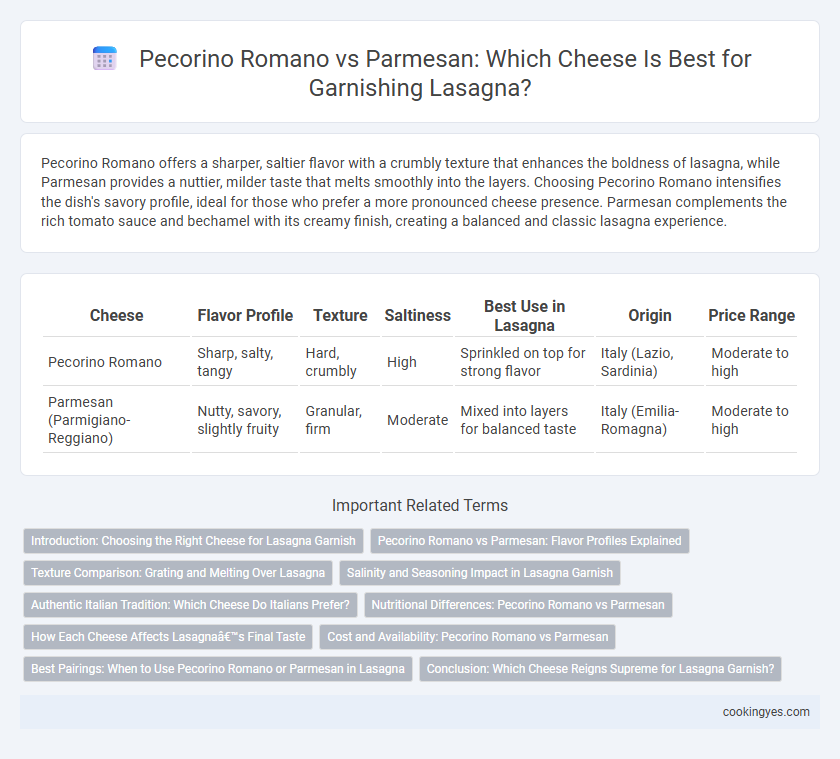Pecorino Romano offers a sharper, saltier flavor with a crumbly texture that enhances the boldness of lasagna, while Parmesan provides a nuttier, milder taste that melts smoothly into the layers. Choosing Pecorino Romano intensifies the dish's savory profile, ideal for those who prefer a more pronounced cheese presence. Parmesan complements the rich tomato sauce and bechamel with its creamy finish, creating a balanced and classic lasagna experience.
Table of Comparison
| Cheese | Flavor Profile | Texture | Saltiness | Best Use in Lasagna | Origin | Price Range |
|---|---|---|---|---|---|---|
| Pecorino Romano | Sharp, salty, tangy | Hard, crumbly | High | Sprinkled on top for strong flavor | Italy (Lazio, Sardinia) | Moderate to high |
| Parmesan (Parmigiano-Reggiano) | Nutty, savory, slightly fruity | Granular, firm | Moderate | Mixed into layers for balanced taste | Italy (Emilia-Romagna) | Moderate to high |
Introduction: Choosing the Right Cheese for Lasagna Garnish
Pecorino Romano offers a sharp, salty flavor that enhances the savory depth of lasagna, pairing well with rich tomato sauces and robust meat layers. Parmesan, known for its nutty and slightly sweet profile, melts smoothly and adds a creamy finish to the dish's garnish. Selecting between Pecorino Romano and Parmesan depends on the desired intensity and texture, with Pecorino providing boldness and Parmesan delivering a balanced, mellow complement.
Pecorino Romano vs Parmesan: Flavor Profiles Explained
Pecorino Romano offers a sharp, salty, and tangy flavor derived from sheep's milk, providing a robust punch that complements the rich tomato sauce in lasagna. Parmesan, made from cow's milk, features a nutty, slightly sweet, and umami-rich profile that melts smoothly and adds depth without overpowering other ingredients. Choosing Pecorino Romano elevates the dish with boldness and saltiness, while Parmesan delivers a balanced, creamy finish, making each cheese suit different taste preferences for lasagna garnish.
Texture Comparison: Grating and Melting Over Lasagna
Pecorino Romano features a coarser texture that grates into larger, drier shreds, delivering a sharper, saltier flavor that stands out when sprinkled over lasagna. Parmesan, with its finer, slightly oily texture, melts more smoothly, blending seamlessly into the layers to create a creamy finish. The choice between Pecorino Romano and Parmesan impacts the lasagna's overall mouthfeel and flavor balance, with Pecorino adding a distinct tang and Parmesan offering a milder, cohesive melt.
Salinity and Seasoning Impact in Lasagna Garnish
Pecorino Romano offers a sharper, saltier profile than Parmesan, intensifying the salinity and elevating the seasoning impact in lasagna garnish. Parmesan provides a milder, nuttier flavor that balances the richness without overpowering the dish. Choosing Pecorino Romano enhances the savory depth, while Parmesan adds subtle creaminess to the lasagna finishing touch.
Authentic Italian Tradition: Which Cheese Do Italians Prefer?
Pecorino Romano is traditionally favored in authentic Italian lasagna recipes, especially in regions like Lazio and Tuscany, due to its sharp, salty flavor derived from sheep's milk. Parmesan, or Parmigiano-Reggiano, offers a milder, nuttier taste and is more commonly used in northern Italy, often grated over finished dishes. Italians prefer Pecorino Romano for its robust profile that enhances the rich sauces and layers of traditional lasagna, maintaining regional authenticity.
Nutritional Differences: Pecorino Romano vs Parmesan
Pecorino Romano contains higher sodium levels compared to Parmesan, making it a saltier garnish option for lasagna. Parmesan offers more calcium and protein per serving, supporting bone health and muscle maintenance. Both cheeses provide key nutrients, but Parmesan's lower sodium and higher calcium content make it a nutritionally preferable choice for lasagna garnish.
How Each Cheese Affects Lasagna’s Final Taste
Pecorino Romano imparts a sharp, tangy, and salty flavor that intensifies the overall taste profile of lasagna, giving it a punchier and more robust character. Parmesan offers a nuttier, milder, and slightly sweet flavor that blends smoothly with the tomato sauce and bechamel, creating a balanced and creamy finish. The choice between Pecorino Romano and Parmesan affects the lasagna's final taste by either emphasizing bold, piquant notes or delivering a more subtle, harmonious richness.
Cost and Availability: Pecorino Romano vs Parmesan
Pecorino Romano generally costs less than Parmesan, making it a budget-friendly option for lasagna garnish. Parmesan is widely available in most grocery stores and offers a milder flavor, while Pecorino Romano's availability can be limited outside specialty shops but provides a sharper, saltier taste. Choosing between the two depends on balancing cost considerations with flavor preference and local accessibility.
Best Pairings: When to Use Pecorino Romano or Parmesan in Lasagna
Pecorino Romano's sharp, salty flavor enhances meat-based lasagnas, cutting through rich tomato sauces and fatty cheeses for a bold finish. Parmesan's nutty, savory profile complements vegetable or bechamel-based lasagnas, adding depth without overpowering delicate ingredients. Using Pecorino Romano for a tangy, intense garnish or Parmesan for a milder, umami-rich touch ensures optimal flavor balance in every lasagna variation.
Conclusion: Which Cheese Reigns Supreme for Lasagna Garnish?
Pecorino Romano offers a sharp, tangy flavor with a saltier profile that enhances the richness of lasagna, while Parmesan provides a nuttier, creamier taste that complements tomato sauces and bechamel layers. For a traditional Italian lasagna garnish, Parmesan is often preferred due to its balanced flavor and smooth melting qualities, which create a harmonious finish. However, Pecorino Romano reigns supreme for those seeking a bold, savory kick that intensifies the overall dish.
Pecorino Romano vs Parmesan for Lasagna Garnish Infographic

 cookingyes.com
cookingyes.com